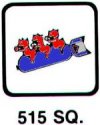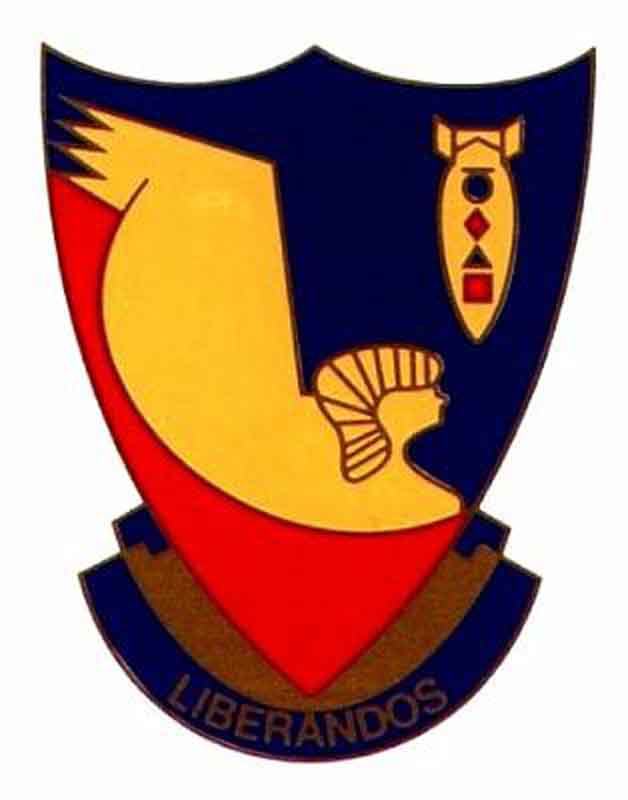Harry S. Hansen, Jr., Mission May 29, 1944
Lt. Harry S. Hansen Jr., of Highland Park, IL, navigator of one of the ill-fated bombers, later told me of his experiences that fateful day of mission May 29, 1944. "As you may remember", he said, "we were shot down by flak over Weiner-Neustadt, Austria. It was about the 30th mission for most of the crew and my 46th as I had flown a few extras with Al Hintenach."
We were flying deputy position and were hit about thirty seconds before 'bombs away'. Six direct bursts of flak hit us and set No. 2 engine on fire, cut all the control cables including the AFCE, and generally tore things up pretty bad. Whaley (the pilot) was still trying the AFCE when I told the crew to hit the silk. I opened the doors and bomb bays, checked with Whaley, and jumped.
"By this time we were in a bad dive. I was slammed against the ship and my chute risers were torn loose. To my embarrassment I found myself tumbling through the air with the unopened chute between my legs. After many desperate tries I untangled the chute and pulled the ripcord - and none too soon, either, for I was hardly more than 50 feet above the ground, or so it seemed! I crashed so hard I broke both my ankles.
One minute I was dealing it out - the next I was on~ receiving end. Two more groups bombed behind ours. That was when I figured that 'I had had it!' as the ground earthquaked around me. The 3erries all were snug in their air raid shelters.
About two hours later the Wehrmacht (Ground Force) boys picked me up. After driving me through the bombed area - where I thought they were going to throw me to the women who had murder in their eyes - I was taken to a collecting point where I met Luther Moore and Sgt. Schermerhorn, one of our waist gunners. Later DeWard was brought in. We found out the rest of the crew had been killed. The Jerries showed me the burnt dog tags of two of our men. I followed S-2 instructions and denied knowing anything about them.
"I spent two days in a small hospital near town. We received good treatment except when there was an air raid on. Then the entire hospital staff beat it for the shelters and left us to dodge our own bombs. We were then sent to Vienna for one night. In front of the railway station in Vienna we met another crew from the 515th Squadron who had gone down the day after us. (Mission No 265, May 30). It was Old Home Week for us, and it was that way the whole of my eleven months behind barbed wire - meeting familiar faces every other day.
"Two days later we were in Dulag Luft (transit air camp) near Frankfort. As you know, that was the big interrogation center. There we were thrown in a cell, hungry and alone, for the night. The next day we were taken out for questioning. At that time the Jerries were more interested in the 8th Air Force and the coming invasion of the mainland so they paid little attention to the 15th Air Force. I wasn't annoyed much by the Jerry interrogators, but I will say it was most interesting.
The officer who interrogated me Dulag Luft, after deciding that I was not going to talk or that I wasn't worth questioning - which was probably more nearly the truth - handed me a manila folder marked '376th Heavy Bombardment Group, San Pancrazio, Italy'. What it contained was a hell of a lot more about the group than you or I, or any person, ever knew about it! They had everything from the radio calls to the color of Colonel Compton's wife's hair. I only wish the Jerry had allowed me to read all of it.
"The afternoon of my interrogation I was sent over to a hospital called 'Homarck'. You may have seen the picture of it in Life magazine taken at the time good old George Patton and his boys pulled in. It was a beautiful place, and I enjoyed my week there which included Red Cross food and cigarettes.
"From Homarck, I was sent to a hospital at Obermassfelt for a couple of months, and from there to a convalescent hospital at Meiningen. Both of those hospitals were manned by British doctors and men who had been captured in the Western Desert of North Africa while fighting Rommel. Some of them said they were riding camels against Rommel's tanks. They didn't think it was much of a war at that time.
"On September 17th I was taken to Stalag Luft III (air prison camp No.3) at Sagan, 90 miles from Berlin. Sagan was strictly an air corps camp. We had such things as books and sports equipment. We were later on to call it a Country Club although it seemed far from a club at that time!
During the winter we were short of food and coal but I noticed no great suffering. Here I met Moore and Matthews from the 515th of the 376th by shouting across the wire. Moore, our bombardier, had a bad leg wound and almost lost it. Matthews and the crew he bailed out with were all O.K. They were the crew that went down shortly before us when I led the formation over Gratz with my damn compass that was off ten degrees. They kidded me a little about that, but were happy to find out what actually happened. Later I found Umphries and several others in my own compound.
"I met and talked to many who were mistreated by the Germans. Some had seen their own crew members hanging from lamp posts where they had been strung up. I was lucky. I was never beat up or mistreated. The worst part of prison life for me was the cold of winter and the lack of food. We all felt mighty low in spirit when the Jerries started the Battle of the Bulge in December. We had been optimistic that the war would end that winter - but no luck.
"In January, as the Russians seemed to be getting close and closer, we figured we would be liberated. On the 29th, with the sound of Russian artillery booming in our ears, we were evacuated on 30 minutes notice. We marched for three days in zero weather. Several of the boys froze to death on that cruel march and many others came close to it. Matthews saw a few men shot to death in his gang for straggling through weakness or sickness.
"The Russians were temporarily stopped so we were next marched to Sprenberg where we were loaded fifty-five men to a box car and hauled across Germany to Stalag VIlA at Moosburg, in Bavaria. Three nights and two days on those 40 and 8 trains, enduring straffing and bombing, was no fun.
"At VIlA we were out of food for almost two weeks. During that time the Germans gave us a thin soup once a day and few slices of bread with some margarine. I lost about 35 pounds but the others were worse off than I. However, the Allies got the White Fleet into operation and things improved. The White Fleet was 50 G.I. trucks, painted white, that the Germans allowed the Red Cross to drive in from Switzerland with food parcels.
"At Stalag VIIA we could see the 8th and the 15th Air Force going over nearly every day. During the night we saw the Royal Air Force bomb Munich with blockbusters. The red glare from the city was terrific. We really felt sorry for the inhabitants. I don't see how they stood it.
"On the 29th of April, eleven months after being shot down, American tanks of the 3rd Army rolled over the hill. Two hours and thirty-five minutes later, at 11:35, the Stars and Stripes went up over Moosburg. I'm not ashamed a bit to tell you we cried and jumped up and down with joy.
"The war was over for us!"
I don't know how I got this, or who talked to me about it - must have been long time ago!
24 Dec 91


The website 376bg.org is NOT our site nor is it our endowment fund.
At the 2017 reunion, the board approved the donation of our archives to the Briscoe Center for American History, located on the University of Texas - Austin campus.
Also, the board approved a $5,000 donation to add to Ed Clendenin's $20,000 donation in the memory of his father. Together, these funds begin an endowment for the preservation of the 376 archives.
Donate directly to the 376 Endowment
To read about other endowment donation options, click here.
Reunion
NOTE change in the schedule !!
DATES: Sep 25-28, 2025
CITY:Rapid City, SD
HOTEL: Best Western Ramkota Conference Hotel; 2111 North LaCrosse St., Rapid City, SD 57702; 605-343-8500
Click here to read about the reunion details.



















